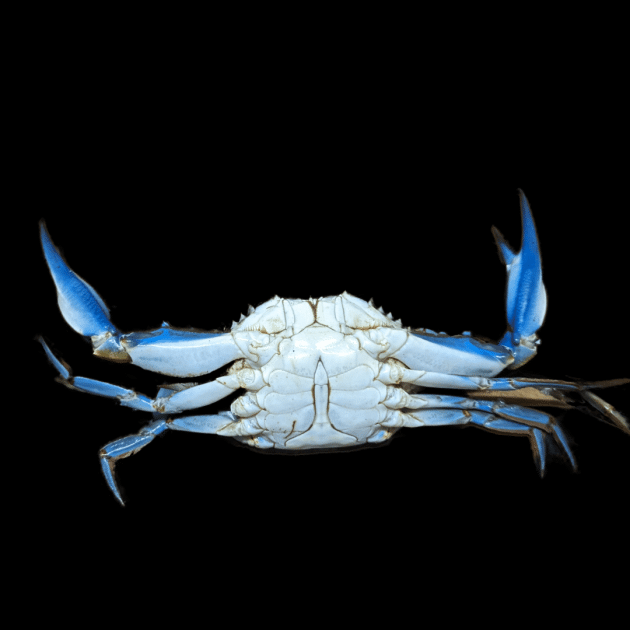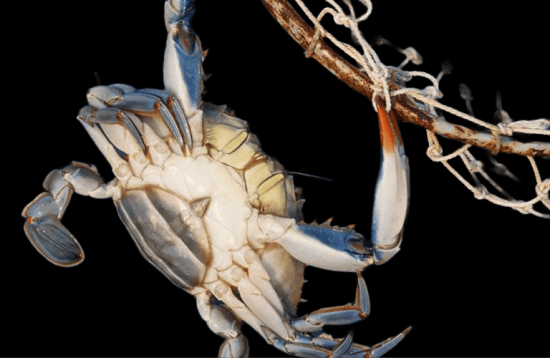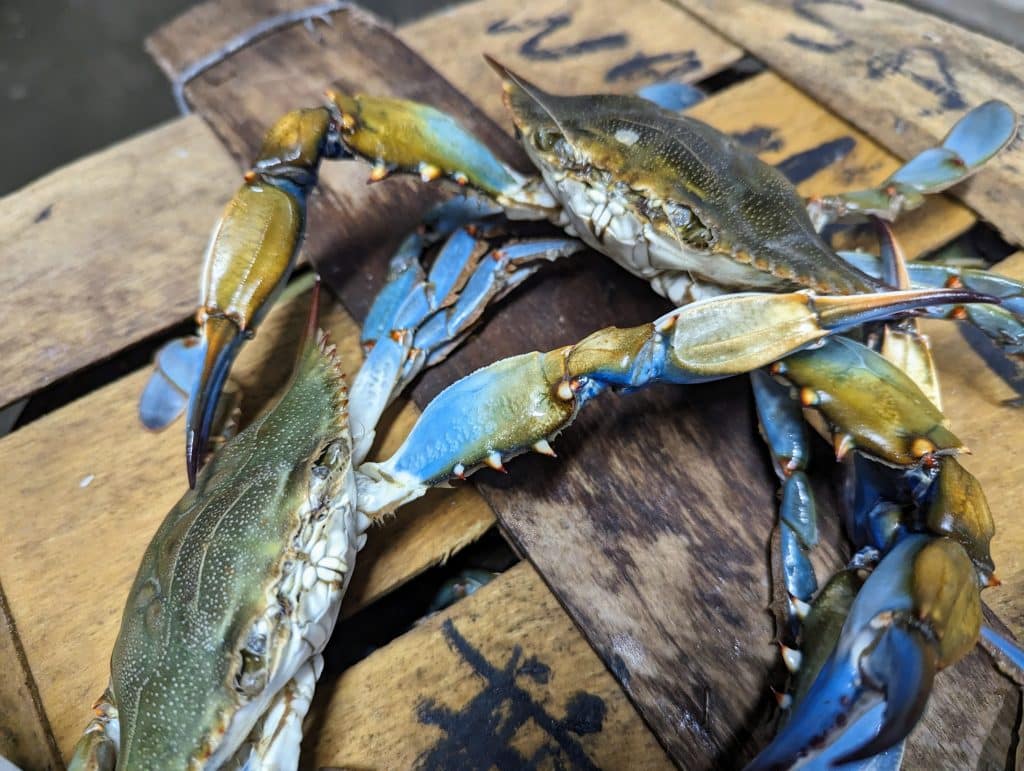Identifying Differences: Male vs. Female Crabs
Physical Differences
When we think Male vs. Female Crabs the first thing that comes to mind is their physical characteristics. One of the most noticeable differences is their abdomens. The abdomen of a male crab, often referred to as the “apron,” which is shaped like a narrow inverted T or a pointed shield. In contrast, female crabs have a broader, rounded apron, resembling the shape of a bell or the Capitol building. This difference is not just a matter of appearance; it plays a crucial role in the reproductive process of crabs.
Another distinguishing feature is the claw size. Male crabs are usually more territorial and competitive. They have larger, stronger claws than females. These enlarged claws are not only a weapon in crabby disputes but also play a vital role in attracting mates.
Male Blue Crab Photo (Male vs. Female Crabs)

Female Blue Crab Photo ( Male vs. Female Crabs )

Behavioral Differences
Behavioral traits can also aid in differentiating between male and female crabs. Males often exhibit more aggressive behavior, especially during mating season. Blue Crabs are known to engage in battles for territory and mates, showcasing their strength and dominance. Females, on the other hand, tend to be less confrontational. During the breeding season, female crabs often carry and protect their eggs, a task that requires a gentler, more nurturing approach.
Online Shipping

We’re excited to announce that we will soon be offering online shipping for our premium Maryland Blue Crabs! This new service will allow you to enjoy the fresh, succulent taste of our crabs from the comfort of your own home, no matter where you are. To make sure you’re among the first to experience this convenience, we invite you to visit our website and sign up for our notification email. By doing so, you’ll be promptly informed as soon as our shipping service goes live. Don’t miss out on this opportunity to have the finest Maryland Blue Crabs delivered straight to your doorstep. Click the button to visit the store to sign-up! 🦀📦🌍
Taste Differences: Male vs. Female Crabs
People in the culinary world have debated the taste differences between male and female crabs for a long time. Taste specifically is what brings up the topic of Male vs. Female Crabs most often. Connoisseurs and casual diners alike often ponder whether there’s a discernible difference in flavor between the two. Let’s crack this shell open and explore what sets them apart in the taste department.
Flavor Profile
The taste difference between male and female crabs, though subtle, is often highlighted by experienced crab enthusiasts. Male crabs, known as “jimmies,” are typically meatier and have a slightly more robust flavor, making them a favorite for dishes that require substantial, chunky crab meat. On the other hand, female crabs, often referred to as “sooks,” are prized for their delicate, sweeter meat. Additionally, females carry roe (crab eggs), which is considered a delicacy in many culinary traditions, adding a rich, buttery dimension to the crab’s flavor profile.
Textural Differences
Aside from taste, the texture of the crab meat can also vary. Males usually have a firmer texture, attributed to their larger muscle mass. This makes their meat ideal for recipes that require crab meat to hold its shape, like crab cakes or stuffed crab shells. Female crab meat is softer and tender, which is desirable in soups, bisques, and sauces. These dishes prefer a delicate texture.
Culinary Preferences
Culinary preferences for male or female crabs can vary by region and culture. In some areas, male crabs are more sought after due to their size and meatiness, making them the star in hearty crab feasts. In other areas, female crabs are valued for their eggs and delicious taste, and are used in fancy dishes. Because of these preference variations we get a lot of curiosity around male vs. female crabs.
To conclude, while the taste differences between male and female crabs are subtle, they are significant enough to influence culinary choices. Both male and female crabs, like the jimmie and the sook, offer delicious experiences for seafood lovers.

Market Trends: Male vs. Female Crabs
The seafood market constantly changes due to the demand for different types of crabs. In this section, we’ll dive into the popularity and market dominance of male and female crabs, exploring how each is perceived and valued in the marketplace which subsequently plays right in hand with male vs. female crabs.
Popularity in Cuisine
The preference for male or female crabs often varies based on regional cuisine and cultural practices. Male crabs are often preferred in dishes that focus on crab because they are bigger and have meatier claws. In contrast, female crabs, with their roe and tender meat, are highly valued in culinary traditions that emphasize subtle flavors and delicacies.
Market Trends
In terms of market trends, the demand and pricing for male and female crabs can fluctuate based on factors such as seasonality, availability, and sustainability practices. Male crabs are usually more expensive, especially the bigger ones, because people think they have more meat and are bigger. Female crabs, while sometimes less in demand, can fetch premium prices when their roe is in season, attracting enthusiasts who seek this unique flavor.
Sustainability and Fishing Practices
Sustainability is a crucial aspect of crab fishing, affecting the availability and market presence of both male and female crabs. Regulations often dictate the harvesting of crabs, with specific guidelines on size and sex to ensure healthy crab populations. In certain regions of the United States, female crab harvest is restricted or limited to certain times of the year to protect their role in reproduction. These conservation efforts not only impact the market dynamics but also play a vital role in maintaining ecological balance.
In summary, the popularity and market dominance of male and female crabs are influenced by a variety of factors, including culinary preferences, economic trends, and sustainability practices. Understanding these nuances provides insight into the complex world of crab fishing and the delicate balance between culinary demand and environmental responsibility.
Cooking and Preparation Tips
Knowing how to cook male and female crabs can enhance your cooking, whether you’re a chef or a home cook. Here, we provide some tips and insights to help you make the most of these delectable crustaceans.
Cooking Male Crabs (Jimmies)
- Optimal Use: Given their larger size and meatier claws, male crabs are ideal for recipes where the crab is the star, such as steamed crabs, crab boils, or grilled crab.
- Preparation Tips: When cooking male crabs, it’s important to ensure they are cooked thoroughly to bring out their robust flavor. Steaming or boiling are popular methods, often accompanied by seasonings like J.O. Seasoning, Old Bay or a mix of aromatic herbs and spices.
- Serving Suggestions: Male crabs are perfect for dishes where you want large, impressive pieces of meat. Consider serving them whole for a traditional crab feast or using the meat in crab cakes or crab-stuffed dishes.
Cooking Female Crabs (Sooks)
- Optimal Use: Female crabs, with their sweeter meat and roe, are excellent in delicate dishes like crab bisques, soups, or sauces.
- Preparation Tips: Gentle cooking methods such as steaming or simmering are ideal for female crabs. Their roe can be a luxurious addition to sauces or as a garnish.
- Serving Suggestions: Utilize the tender meat of female crabs in recipes that highlight their delicate flavor. They are particularly well-suited to recipes where the crab meat is integrated into the dish, such as in pastas, risottos, or savory crab tarts.
General Cooking Advice (Male vs. Female Crabs)
- Freshness is Key: Always start with fresh, high-quality crabs for the best flavor and texture.
- Cooking Times: Be careful not to overcook crab meat as it can become tough and lose its delicate flavor. Follow recommended cooking times closely.
- Seasoning: Crabs pair well with a variety of seasonings, from simple salt and pepper to more elaborate spice mixes. Experiment to find what best suits your palate.
In conclusion, whether you choose male or female crabs, each offers a unique culinary experience. To make delicious crab dishes, learn about each crab’s traits and cook them in a way that brings out their flavors.
Conservation and Ethical Considerations
Conservation and ethics are very important in the world of seafood, especially in crabbing. It is important to understand these aspects. They help with sustainable cooking and protecting marine ecosystems.
Importance of Sustainable Fishing
To protect crab populations for the future, it is vital to fish sustainably. Overfishing and improper harvesting methods can lead to a significant decrease in crab populations, upsetting the balance of marine ecosystems. Consumers and the fishing industry must follow rules to protect crab species. Rules include size limits, seasonal restrictions, and gender-based harvesting.
Ethical Harvesting
When you go crabbing it is important to consider the impact on crab populations and the environment. This includes practices like:
- Avoiding the capture of undersized crabs or those in the breeding process.
- To help crabs reproduce, it’s important to return female crabs, especially those with eggs, to their habitat.
- Using fishing methods that minimize harm to crabs and other marine life.
Consumer Responsibility
As consumers, we can influence the market to be more sustainable by making informed choices. This can include:
- Choosing to buy crabs from sources that practice sustainable fishing.
- Being aware of and respecting seasonal guidelines and size limits.
- Opting for certified sustainable seafood products.
Future of Crab Fisheries ( Male vs. Female Crabs )
The future of crab fisheries depends heavily on our actions today. We can help crabs thrive in their habitats and keep them in our culinary traditions.
In conclusion, when we enjoy eating male and female crabs, we need to think about how it affects the environment and crab populations. We must care for the oceans and support sustainable practices to protect marine life.
Conclusion
As we come to the end of our exploration into the world of “Male vs. Female Crabs,” we’ve uncovered fascinating insights about these marine creatures. Crabs have physical and behavioral differences that help us tell males from females. The taste and texture of crabs also affect what we choose to cook. Market trends are influenced by sustainability and ethical practices, too. All these aspects help us understand and appreciate crabs.
No matter if you love crabs, food, or learning about the ocean, these creatures are fascinating. They’re important too. The conversation one way or another will always be male vs. female crabs. But the choice between male and female crabs isn’t just about taste. It also involves conservation and ethical seafood consumption.
In closing, let’s remember that our choices at the market and in the kitchen have a broader impact on the health of marine ecosystems and the future of crab populations. To help crabs survive, we should pick crabs that are sourced sustainably and support responsible fishing. This way, we can still enjoy their tasty delights.

